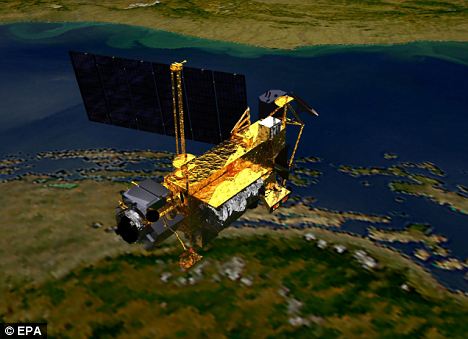
The dead satellite fell into a part of the southern Pacific Ocean about as far from large land masses as you can get, NASA officials said on Tuesday.
NASA calculations put the 6-tonne satellite‘s death plunge early Saturday thousands of miles from northwestern North America, where there were reports of sightings.
Instead, the satellite plunged into areas where remote islands dot a vast ocean.
NASA says those new calculations show the 20-year-old satellite entered Earth’s atmosphere generally above American Samoa.
But falling debris as the satellite broke apart did not start hitting the water for another 300 miles to the northeast, southwest of Christmas Island, just after midnight EDT Saturday.

Experts believe about two dozen metal pieces from the bus-sized satellite fell over a 500-mile span.
“It’s a relatively uninhabited portion of the world, very remote,” NASA orbital debris scientist Mark Matney said.
“This is certainly a good spot in terms of risk.”
Scientists who track space junk couldn’t be happier with the result.
“That’s the way it should be. I think that’s perfect,” said Bill Ailor, director of the Center for Orbital and Reentry Debris Studies at the Aerospace Corp.
“It’s just as good as it gets.”
Last Saturday, scientists said it was possible some pieces could have reached northwestern Canada and claims of sightings in Canada spread on the Internet.
However, NASA said Tuesday that new calculations show the satellite landed several minutes earlier than they thought, changing the debris field to an entirely different hemisphere.
“It just shows you the difference that 10 or 15 minutes can make,” said Harvard University astrophysicist Jonathan McDowell, who tracks man-made space objects. On Saturday, he noted: “We were talking about, <<Wow, did it hit Seattle?>>”
NASA won’t say how it knows the climate research satellite came in earlier, referring questions to the U.S. Air Force space operations centre.
Air Force spokeswoman Julie Ziegenhorn said better computer model reconstruction after the satellite fell helped pinpoint where the satellite (Upper Atmosphere Research Satellite) returned to Earth.
After UARS was launched in 1991, NASA and other space agencies adopted new procedures to lessen space junk and satellites falling back to Earth. So NASA has no more satellites as large as this one that will fall back to Earth uncontrolled in the next 25 years, according to NASA orbital debris chief scientist Nicholas Johnson.
But other satellites will continue to fall. Late in October, or early in November, a German astronomy satellite is set to plunge uncontrolled back to Earth.
While slightly smaller than UARS, the German satellite is expected to have more pieces survive re-entry, said Jonathan McDowell, who worked on one of the instruments for it.
The German ROSAT satellite was launched in 1990, died in 1998 and weighs 2 ½ tons. The German space agency figures 30 pieces weighing less than 2 tons will survive re-entry. Debris may include sharp mirror shards.
The German space agency puts the odds of somebody somewhere on Earth being hurt by its satellite at 1-in-2,000 – a slightly higher level of risk than was calculated for the NASA satellite. But any one individual’s odds of being struck are 1-in-14trillion, given there are 7 billion people on the planet.